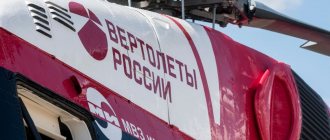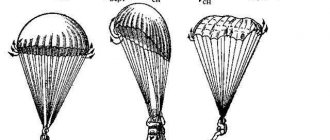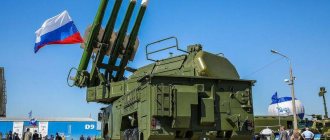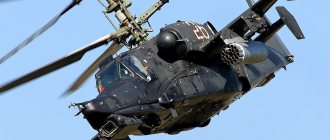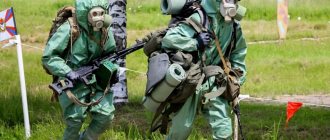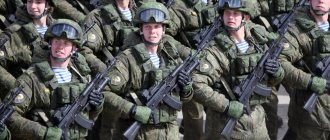06/14/2019 Category: Airborne troops
- 2 History of creation
- 3 Formation of troops in the USSR
- 4 Airborne troops in the modern army
- 5 Structure of the Russian Airborne Forces
- 6 Armament of the Airborne Forces
- 7 Dress code
- 8 Holiday
- 9 Interesting facts
Airborne troops (Airborne Forces) are an independent branch of the Armed Forces of the Russian Federation, designed for operational landing and combat operations behind enemy lines. The Airborne Forces are the reserve of the Supreme Commander-in-Chief and are directly subordinate to the Airborne Forces commander.
Airborne troops
General information and main tasks of the Airborne Forces
Airborne troops perform the following tasks:
- violation of enemy command and control;
- destruction of ground elements of precision weapons;
- failure to deploy reserves;
- disruption of the work of rear structures and communications;
- covering individual directions, areas and flanks;
- blocking and destroying enemy airborne assault forces and enemy groups that have broken through.
Airborne units are delivered to the combat area using airplanes, helicopters or gliders, and therefore are often used as quick reaction forces in local conflicts.
Paratroopers in gear and ready for takeoff
Formation of troops in the USSR
The first landing of troops took place in Turkestan in 1929 during the capture of the city of Garm. Then a detachment of Red Army soldiers was parachuted into territory controlled by the Basmachi and destroyed the enemy.
Created in 1931, the aviation motorized landing force had already grown to 29 airborne battalions by 1933. They were armed not only with small arms in the form of machine guns and sniper rifles, but also light tanks, motorcycles, 76 mm guns and armored personnel carriers.
In 1935, the first mass landing exercises took place in the Kiev Military District. 1188 Red Army soldiers captured the “enemy” airfield within 2 hours.
In 1936, 3,000 paratroopers and 8,000 people landed on the territory of the Belarusian Military District. At the same time, they landed together with light military equipment. The exercises turned out to be so large-scale and effective that they were reflected in the assessment of foreign observers.
Landing of military personnel from their aircraft
During the Great Patriotic War, the widespread use of airborne troops led to the formation of 10 regiments and 5 brigades by 1943. In 1942, the first Airborne Forces School was created in the city of Kuibyshev.
For heroism and courage during the war, 296 paratroopers received the highest award - Hero of the Soviet Union, and thousands of paratroopers were awarded orders and medals.
Since July 10, 1946, the Airborne Forces have been part of the country's Ground Forces, reporting directly to the USSR Minister of Defense, and since 1953 they have become his main reserve.
In the 50s - 80s of the twentieth century, airborne troops participated in many local conflicts in Europe and on other continents. Combat operations in Prague and Bratislava, Czechoslovakia, Angola, and Afghanistan were carried out by airborne forces. Moreover, this is not a complete list of countries and cities in which Soviet paratroopers were able to relieve the intensity of political passions and stop fratricidal wars.
The best of the best: existential drama of the Airborne Forces
And now you are free! House slippers purr at your feet. You can sleep as much as you want, eat as much as you want and generally live however you want. You have experienced a lot in these two years and you want to tell everyone about it. But... Nobody gives a damn.
Yesterday's support platoon squad leader goes to work as a minibus driver. For the first time, of course, but there is nothing more permanent than temporary. Especially when this temporary is supported by real money that is handed to you every minute. Yesterday's signalman goes to work as an electrician at a construction site. The work is dirty, although the pay is good. The scout goes to the private security company or to the cops. To the PPS company, if you're lucky. Others, returning to provincial small towns, do not go anywhere.
And so it turns out that all these people who jumped out of the plane before landing, shot from various weapons, froze in the trenches during exercises, walked tens of kilometers on marches, and so on, all these people turn into ordinary Russians. Into that same grayness that fills bus stops on autumn mornings. Those who take out a second loan to pay off the first. In those who shout “Bitter!” at the wedding and participates in all the idiotic toastmaster competitions. It all sounds and looks, of course, terrible. Just think about these two words: ORDINARY RUSSIAN. Against this background, for many people, service in the army and, in particular, in the Airborne Forces is the only achievement of their life.
Once I had a chance to look at a demobilization album, which was issued back in the days of queues and shortages. The design deserves special attention, but what struck me most were the portrait photographs of my colleagues... There were about thirty of them. They were all taken in the same photo studio, from the same angles, and the faces in these photographs were very reminiscent of the film actors from the film about spring on Zarechnaya Street. Typical good Soviet people, whom you don’t meet anymore. Due to the fact that people tend to idealize their past and compare it with the present, the story about the service of the owner of the album was in the best traditions: “We served, it was good, but now everywhere is full of crap and they only serve for a year!”
And then the conversation turned to colleagues. My interlocutor talked about his army comrades, whom he had not seen for more than 20 years, as if they were some kind of gods or apostles, no less. For him, all these people remained young, cheerful, and responsive. Preserved in his memory, they continued to be his friends and, in some way, ideals: “Here is Sashka from Moscow! We had a sergeant. Now, probably, not the last person in Moscow. He was going to go to the police!” Or: “And this is Mishka! Do you know where? From Gelendzhik! I always wanted to go there. I even have his address, can you imagine?”
During this short conversation, I wanted to ask my interlocutor if he knew about what social networks are? However, the more I listened to him, the more I realized that this man had nothing to do there (on social networks), because all his colleagues with a high degree of probability turned from handsome, young and fit guys into typical Russian citizens with disproportionate torsos, aggressive wrinkles on their faces and completely earthly problems. That is, all these people, I am sure, have become the same as my interlocutor. Breaking this bright, life-affirming pattern, in my opinion, can be very dangerous when most of your life has already been lived, and the present is so bad that you want to continue to live in the past.
And, probably, the most unpleasant thing about communicating with former colleagues is that you simply have nothing to talk about. He found you (or you him) in some Odnoklassniki, you told each other about how the last few years of your often worthless, completely simple and therefore uninteresting lives went, remembered the past and... EVERYTHING! There is nothing more to say. The template is torn. The ghosts of youth descended from heaven, received a Russian passport and disappeared into a sea of the most ordinary problems.
Or sometimes he will take you to the cemetery, you go and look at the graves.
At first, all the graves seem the same, but a lot of interesting things can be noticed if you pay attention to the dates of birth/death, as well as in the photographs. About a twentieth of the grave photographs, prints and engravings that I saw depicted people in military uniform... It would seem that everything is clear. If the gravestone photo shows a person in uniform, it means that the person buried is a military man. But it seems to me that everything is not so simple. If you pay attention to the dates of birth and death, you will notice that the person died at about 35 - 40 years old. But then why is the photo showing a 20-year-old guy? Most likely, army photographs are the only photographs in which a person looks normal. It is in the army photo that the now deceased man is depicted fit, fresh, sober, young and fragrant.
I don’t know why, but my imagination paints something like the following picture. Here is a man who lives in peace: he plows the land, drinks vodka on weekends, and repairs his Zhiguli in the garage. Well, he breaks his leg at the sawmill - some kind of variety. And then one day - BAM and the person is gone. They put him in a coffin, mourn him, this and that. Relatives begin to look for the photograph on the tombstone. They sit and look through photo albums: “Let’s get this one?” - Yes, he’s drunk here! - And this one? - And here he’s naked... - And this one? - And here there is no tooth... - But here is a good army photo... He’s so young and handsome here. Give it to me? - Lets do it…
However, away with despondency.
Once a year in August there comes a day when you can show all the people around you that everything is not in vain. You are not like everyone else, you served, you don’t regret anything, and on this day you will return to your element for a few hours. And this August day always counts towards the whole year.
Happy holiday.
Airborne troops in the modern army
The Airborne Forces of the Russian Federation are the legacy of the Union of Soviet Socialist Republics, divided in 1992 between the union republics. The troops became the reserve of the Supreme Commander-in-Chief, the main tasks remained unchanged.
Airborne troops during a ceremonial march
Command
From October 4, 2016 to the present, the Commander of the Airborne Forces is Colonel General A. N. Serdyukov; before him, this post was held from 2009 to 2016 by V. A. Shamanov (rank of Colonel General).
Deputy Commanders of the Airborne Forces
The position of deputy commander of the Blue Berets is occupied by several people:
- the chief of staff is the first deputy commander of the airborne forces, Lieutenant General N. Ignatov;
- second deputy - A. Kholzakov (rank of lieutenant general);
- Major General N. Timergazin is responsible for the logistics of the department;
- Deputy Commander of the Airborne Forces, responsible for peacekeeping operations and CRRF - Lieutenant General A. Vyaznikov;
- head of airborne training - Lieutenant General V. Kochetkov;
- Deputy Commander for Work with Personnel - Major General V. Kupchishin.
The Supreme Commander-in-Chief of the Russian army is the President of the Russian Federation. Based on Art. 83 of the Constitution, the head of state can appoint and dismiss high command.
Structure of the Russian Airborne Forces
The Russian Airborne Forces consist of command structures, combat units and units, as well as support units.
Structurally, the Airborne Forces have three main components:
- airborne;
- air assault;
- mountain - air assault units designed to operate in mountainous areas.
The Russian Airborne Forces include four divisions, as well as separate brigades and regiments:
- 76th Guards Air Assault Division, stationed in Pskov.
- 7th Guards Air Assault (Mountain) Division, stationed in Novorossiysk.
- 98th Guards Airborne Division, located in Ivanovo.
- 106th Guards Airborne Division - Tula.
- 11th Separate Guards Airborne Brigade, based in Ulan-Ude.
- 45th separate guards special purpose brigade (Moscow).
- 56th Separate Guards Air Assault Brigade. Place of deployment - the city of Kamyshin.
- 31st Separate Guards Air Assault Brigade. Located in Ulyanovsk.
- 83rd Separate Guards Airborne Brigade. Location: Ussuriysk.
- 38th Separate Guards Airborne Communications Regiment. Located in the Moscow region, in the village of Medvezhye Ozera.
In addition, the Russian Airborne Forces include educational institutions:
- Ryazan Higher Airborne Command School;
- Tula Suvorov School;
- Ulyanovsk Suvorov School;
- Omsk Cadet Corps;
- The 242nd training center, located in Omsk.
Formation at RVVDKU
Armament of the Airborne Forces
The airborne troops are armed with the same small arms as other troops, but with special modifications: a folding stock for machine guns and carbines. Silent shooting devices were also developed - PBS for pistols, machine guns and rifles.
Small arms for special-purpose units are represented not only by silent weapons such as “Val” and “Vintorez”. The Airborne Forces were the first to receive the latest AK-12 assault rifles and IED rifles with a bullpup cartridge supply system. This system differs in the location of the magazine in the butt, which makes the rifle shorter.
Airborne combat vehicles - BMD-1, BMD-2M, BMD-3 and BMD-4 and armored personnel carriers BTR-80, BTR-D accompany the air infantry in all operations.
Construction of personnel and weapons of the Airborne Forces
The main anti-tank weapons of the Airborne Forces are the 2S25 Sprut-SD self-propelled anti-tank gun, the Robot BTR-RD complexes, as well as the Metis, Fagot, Konkurs and Kornet ATGMs.
Modern military equipment is designed in such a way that it is suitable for landing from an aircraft, with a crew on board.
Vasily Filippovich Margelov - “father” of the Airborne Forces
A huge role in the development of airborne troops, the development of the theory of their use and the development of weapons belongs to the commander of the Airborne Forces from 1954 to 1979, Vasily Filippovich Margelov. It is in his honor that the Airborne Forces are jokingly called “Uncle Vasya’s troops.” Margelov laid the foundation for positioning the airborne troops as highly mobile units with high firepower and covered with reliable armor. It was precisely this kind of troops that were supposed to deliver quick and unexpected strikes against the enemy in a nuclear war. At the same time, the task of the Airborne Forces in no case should have included long-term retention of captured objects or positions, since in this case the landing party would certainly be destroyed by regular units of the enemy army.
Under the influence of Margelov, special models of small arms were developed for airborne units, allowing them to fire effectively even during landing, special models of cars and armored vehicles, and the creation of new transport aircraft intended for landing and armored vehicles.
It was on Margelov’s initiative that the special symbols of the Airborne Forces were created, familiar to all modern Russians - the vest and blue beret, which are the pride of every paratrooper.
Dress
For everyday wear, a standard military uniform is used, with the exception of the blue beret, recognizable throughout the world. Only Russian paratroopers wear a blue beret. The paratroopers of other countries take maroon, crimson or red. The buttonholes, shoulder straps, band on the cap and piping on the uniform trousers are also blue.
Another distinctive feature of the paratrooper uniform is the vest. Unlike the naval undershirt, the paratrooper’s “vest” has light blue stripes. Airborne Forces Commander V.F. Margelov often checked his officers for wearing this attribute of the uniform. And if under his uniform the officer had standard underwear instead of a vest, he was shown the door.
During field training, a soldier's headdress is a cap, hat or Panama hat.
The field uniform has changed many times over the decades. The reason for this was the constant work to improve and modernize clothing based on the results of combat and training operations. For example, after the events in Angola and a number of other African countries, the famous “mabuta” was developed - a field uniform with patch pockets on a soldier’s trousers and jacket. And among the paratroopers, the uniform received its name from the name of General Mabuta, who was assisted in that local conflict on the territory of an African state.
Airborne uniform then and now
The paratroopers are the first to receive all the new military uniforms. After all, they, like no one else, can check its convenience, wearability, quality, etc. Another example of such a form, born of a military conflict, is the “slide,” which became widely used after the war in the Caucasus.
